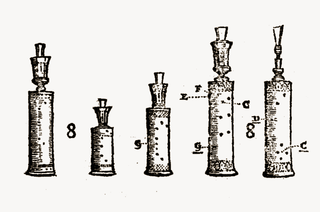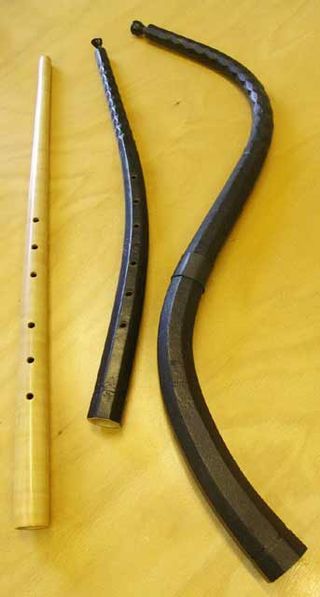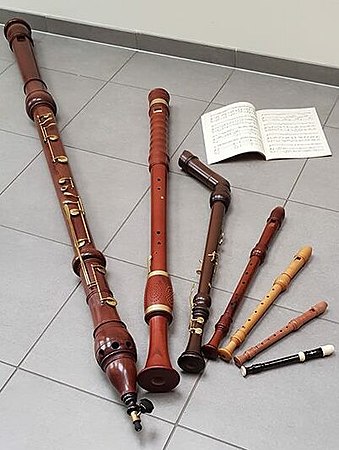
The recorder is a family of woodwind musical instruments in the group known as internal duct flutes: flutes with a whistle mouthpiece, also known as fipple flutes. A recorder can be distinguished from other duct flutes by the presence of a thumb-hole for the upper hand and seven finger-holes: three for the upper hand and four for the lower. It is the most prominent duct flute in the western classical tradition.

The word lituus originally meant a curved augural staff, or a curved war-trumpet in the ancient Latin language. This Latin word continued in use through the 18th century as an alternative to the vernacular names of various musical instruments.

In organology, the study of musical instruments, many methods of classifying instruments exist. Most methods are specific to a particular cultural group and were developed to serve that culture's musical needs. Culture-based classification methods sometimes break down when applied outside that culture. For example, a classification based on instrument use may fail when applied to another culture that uses the same instrument differently.

The shawm is a conical bore, double-reed woodwind instrument made in Europe from the 12th century to the present day. It achieved its peak of popularity during the medieval and Renaissance periods, after which it was gradually eclipsed by the oboe family of descendant instruments in classical music. It is likely to have come to Western Europe from the Eastern Mediterranean around the time of the Crusades. Double-reed instruments similar to the shawm were long present in Southern Europe and the East, for instance the ancient Greek, and later Byzantine, aulos, the Persian sorna, and the Armenian duduk.
Contrabass refers to several musical instruments of very low pitch—generally one octave below bass register instruments. While the term most commonly refers to the double bass, many other instruments in the contrabass register exist.

The contrabass clarinet (also pedal clarinet, after the pedals of pipe organs) and contra-alto clarinet are the two largest members of the clarinet family that are in common usage. Modern contrabass clarinets are transposing instruments pitched in B♭, sounding two octaves lower than the common B♭ soprano clarinet and one octave below the bass clarinet. Some contrabass clarinet models have extra keys to extend the range down to low written E♭3, D3 or C3. This gives a tessitura written range, notated in treble clef, of C3 – F6, which sounds B♭0 – E♭4. Some early instruments were pitched in C; Arnold Schoenberg's Fünf Orchesterstücke specifies a contrabass clarinet in A, but there is no evidence such an instrument has ever existed.

The contra-alto clarinet, E♭ contrabass clarinet, is a large clarinet pitched a perfect fifth below the B♭ bass clarinet. It is a transposing instrument in E♭ sounding an octave and a major sixth below its written pitch, between the bass clarinet and the B♭ contrabass clarinet.

The rackett, raggett, cervelas, or sausage bassoon is a Renaissance-era double reed wind instrument, introduced late in the sixteenth century and already superseded by bassoons at the end of the seventeenth century.
The alto clarinet is a woodwind instrument of the clarinet family. It is a transposing instrument pitched in the key of E♭, though instruments in F have been made. In size it lies between the soprano clarinet and the bass clarinet. It bears a greater resemblance to the bass clarinet in that it typically has a straight body, but a curved neck and bell made of metal. All-metal alto clarinets also exist. In appearance it strongly resembles the basset horn, but usually differs in three respects: it is pitched a whole step lower, it lacks an extended lower range, and it has a wider bore than many basset horns.
The soprano recorder in c2, also known as the descant, is the third-smallest instrument of the modern recorder family and is usually played as the highest voice in four-part ensembles. Since its finger spacing is relatively small, it is often used in music education for children first learning to play an instrument.

The bassanello was a Renaissance double reed woodwind instrument which was described in 1619 by Michael Praetorius in his Syntagma Musicum II:

The tenor cornett or lizard was a common musical instrument in the Renaissance and Baroque periods. This instrument was normally built in C and the pedal (lowest) note of the majority of tenor cornetts was the C below middle C. A number of surviving instruments feature a key to secure the lowest note. The instrument has a useful range of approximately two and a half octaves, however, an experienced player with a strong embouchure may be able to push the instrument higher.

Zuffolo (also chiufolo, ciufolo) is an Italian fipple flute. First described in the 14th century, it has a rear thumb-hole, two front finger-holes, and a conical bore. It is approximately 8 cm in length and has a range of over two octaves, from B3 to C6 (Marcuse 1975c). A larger instrument of the same name, with a lowest note of C5 appeared in the early 17th century (Fuller-Maitland, Baines, and Térey-Smith 2001).

The clarinet family is a musical instrument family of various sizes and types of clarinets, including the well-known B♭ clarinet, his "brother" A clarinet, the bass clarinet, and the slightly less familiar E♭ and among others.

The great bass recorder is a member of the recorder family. With the revival of the recorder by Arnold Dolmetsch, who chose Baroque music and the corresponding recorder types as a fixed point, consideration was given to the design of recorder types larger than the bass recorder. The great bass recorder has up to seven keys, which serve to facilitate access to the finger holes. For modern large bass recorders woods like maple or African Bubinga are used. The term usually applies to an instrument with range is c–d2 (g2), but has also been used to describe an instrument descending to B♭ or else to the low bass recorder in F, alternatively known as a contrabass. When "great bass" is used for the instrument in low F, the instruments in C and B♭ are referred to as "quart-bass" and "quint-bass", respectively, because they are a fourth and fifth below the ordinary small bass, or "basset". The prefixes "great" and "contra" refer to the registers from C to B and from ͵C to ͵B, respectively, in Helmholtz pitch notation.
The sopranino recorder is the second smallest recorder of the modern recorder family, and was the smallest before the 17th century.
The alto recorder in F, also known as a treble (and, historically, as consort flute and common flute) is a member of the recorder family. Up until the 17th century the alto instrument was normally in G4 instead of F4.
The garklein recorder in C, also known as the sopranissimo recorder or piccolo recorder, is the smallest size of the recorder family. Its range is C6–A7 (C8). The name garklein is German for "quite small", and is also sometimes used to describe the sopranino in G. Although some modern German makers use the single-word form Garkleinflötlein, this is without historical precedent. Double holes for the two lowest notes (used on the larger recorders to achieve a fully chromatic scale) are uncommon. The instrument is usually notated in the treble clef two octaves lower than its actual sound. The garklein recorder is only about 16 to 18 cm long and is different from larger recorders in that it is usually made in one piece due to its size.

A bass recorder is a wind instrument in F3 that belongs to the family of recorders.

The tenor recorder is a member of the recorder family. It has the same form as a soprano recorder and an alto recorder, but it produces a lower sound than either; a still lower sound is produced by the bass recorder and great bass recorder.















